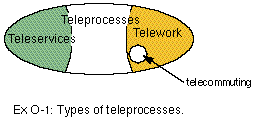
![]()
Telecommuting is an appealing and productive work practice that managers in both the private and public sectors are exploring and implementing. Telecommuting has organizational and personal benefits that are so positive that the travel savings that occur are frosting on an already tasty cake. That the travel savings are small when measured against the whole transportation picture in a modern economy does not mean that telecommuting is unworthy of pursuit. On the contrary, telecommuting works so well for many organizations that it would be important to implement it even if the result were increased employee commuting mileage. Still, telecommuting is only a small part of a large and expanding set of teleprocesses that govern how the National Information Infrastructure makes an impact on transportation.
Teleprocesses are all of the new work techniques and arrangements of organizations and individuals that voice, data, and video telecommunications allow. Such processes include telework, which affects the location of workers in ways that may go beyond telecommuting. As Exhibit O-1 illustrates, telecommuting is just a fraction of telework. Teleprocesses also include teleservices, which affect the locations of customers of both product and service organizations.

![]()
Telework and teleservices encompass present and future applications of the NII in the manufacturing, health care, K-12 education, and government sectors of the economy. The opportunities for general societal benefits in each of these sectors, as well as in other sectors by extension and generalization, are more significant than travel savings.
For example, an electronically networked system of specialized national medical centers, regional hospitals, and smaller rural and neighborhood clinics can deliver appropriate levels of care (open-heart surgery, appendectomies, or immunizations) and personal attention at the appropriate location. In each place, appropriately trained medical professionals are all teleworkers. They are supported by teleprocess access to patient medical histories and by teleservices that expand local medical know-how on symptoms, treatments, and outcomes.
For public education, the tradition of widely dispersed community schools and face-to-face interaction for socialization and learning will continue, but local teaching and learning can be enhanced by teleservices providing access to people and information in the next county or on the other side of the world. Teleservices are also key resources for extending learning environments into homes, offices, libraries, and community centers.
Other government services and processes, from field inspections to forms processing, are amenable to revision through applications of voice, data, and video telecommunications. These applications can be designed to improve quality and access and can reduce or avoid costs. Sometimes agencies can use information technology to deliver information-based services, such as access to filed records, in a matter of minutes instead of hours or days and by telephone rather than in person. As other examples, remote air quality monitors and utility meters can be queried by phone, geographic databases can be checked from the field, reports can be written and transmitted to computer files from the field, and surveillance of unstaffed facilities can be maintained from miles away via remote video.
Modern manufacturing teleprocesses increase the responsiveness of production to the immediate needs of purchasers by putting more raw materials and finished products into computer-coordinated shipments with location-tracking systems, rather than depending on large inventories in warehouses and storerooms. The agile, just-in-time methods of manufacturing are beginning to be adopted in the service sectors of the economy as well.
Improving the availability and performance of telecommunications leads to gains in organizational performance and overall economic development. These gains from enhancing the NII do not necessarily lead to simultaneous reductions in travel.
The travel substitution characteristics of telecommunications continue to be acclaimed. Some policy mavens declare that telecommunications can be thought of as "information transportation." Instead of moving people and paper in vehicles riding on heavy, costly infrastructure, the information in people's heads, desks, briefcases, and computer files is transmitted at the speed of light through cables and the air. Indeed, telecommuting is not the only way that telecommunications can act as a substitute for transportation. Other examples beyond telecommuting include the following:
This report provides additional, cautionary perspectives on the idea that telecommunications is exclusively a force for reducing the need to travel. We explore how applications of telecommunications can act as a trip substitute and simultaneously as a travel stimulant.
![]()
Go to:
![]()